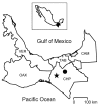Ocozocoautla de espinosa virus and hemorrhagic fever, Mexico
- PMID: 22377271
- PMCID: PMC3309595
- DOI: 10.3201/eid1803.111602
Ocozocoautla de espinosa virus and hemorrhagic fever, Mexico
Abstract
Arenavirus RNA was isolated from Mexican deer mice (Peromyscus mexicanus) captured near the site of a 1967 epidemic of hemorrhagic fever in southern Mexico. Analyses of nucleotide and amino acid sequence data indicated that the deer mice were infected with a novel Tacaribe serocomplex virus (proposed name Ocozocoautla de Espinosa virus), which is phylogenetically closely related to Tacaribe serocomplex viruses that cause hemorrhagic fever in humans in South America.
Figures


References
-
- Salvato MS, Clegg JC, Buchmeier MJ, Charrel RN, Gonzalez J-P, Lukashevich IS, et al. Family Arenaviridae. In: Fauquet CM, Mayo MA, Maniloff J, Desselberger U, Ball LA, editors: Virus taxonomy: eighth report of the International Committee on Taxonomy of Viruses. New York: Elsevier Academic Press; 2005. p. 725–33.
-
- Milazzo ML, Cajimat MNB, Haynie ML, Abbott KD, Bradley RD, Fulhorst CF. Diversity among Tacaribe serocomplex viruses (family Arenaviridae) naturally associated with the white-throated woodrat (Neotoma albigula) in the southwestern United States. Vector Borne Zoonotic Dis. 2008;8:523–40. 10.1089/vbz.2007.0239 - DOI - PMC - PubMed
-
- Cajimat MN, Milazzo ML, Bradley RD, Fulhorst CF. Catarina virus, an arenaviral species principally associated with Neotoma micropus (southern plains woodrat) in Texas. Am J Trop Med Hyg. 2007;77:732–6. - PubMed
Publication types
MeSH terms
Substances
Associated data
- Actions
- Actions
Grants and funding
LinkOut - more resources
Full Text Sources
Molecular Biology Databases
